July Recap: West Hit with Extreme Heat, Drought and Unrelenting Fires
Special Stories
11 Aug 2021 2:00 AM
[A fire cloud over the ridgeline rising from the Bootleg wildfire in Oregon, July 7, 2021. From InciWeb via NOAA]
[Written by NOAA and NOAA NCEI] July turned out to be an exceptional month of triple threats for the western U.S., with record heat, drought and raging wildfires. The nation as a whole had a hot July — with extreme rainfall in areas already saturated while sparing others that needed it most.
Here’s a climate snapshot of the month of July and the year to date, according to scientists from NOAA’s National Centers for Environmental Information:
Climate by the numbers
July 2021
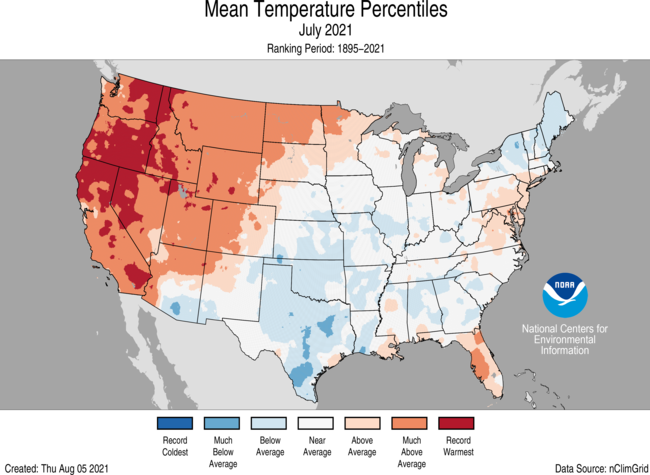 The average temperature last month across the contiguous U.S. was 75.5 degrees F (1.9 degrees above average), placing July 2021 in the 13th-warmest spot in the 127-year record.
A ridge of high pressure across the western U.S and a trough across the eastern U.S. for most of July kept the temperatures well-above average across the West and more moderate across the central and eastern states. This pattern remained in place for the duration of the month. An eastward shift in the ridge mid-month allowed the southwestern monsoon to kick off.
California, Nevada, Oregon and Washington had their hottest Julys on record. Five other states — Idaho, Montana, North Dakota, Utah and Wyoming — saw their top-10 hottest Julys.
The average temperature last month across the contiguous U.S. was 75.5 degrees F (1.9 degrees above average), placing July 2021 in the 13th-warmest spot in the 127-year record.
A ridge of high pressure across the western U.S and a trough across the eastern U.S. for most of July kept the temperatures well-above average across the West and more moderate across the central and eastern states. This pattern remained in place for the duration of the month. An eastward shift in the ridge mid-month allowed the southwestern monsoon to kick off.
California, Nevada, Oregon and Washington had their hottest Julys on record. Five other states — Idaho, Montana, North Dakota, Utah and Wyoming — saw their top-10 hottest Julys.
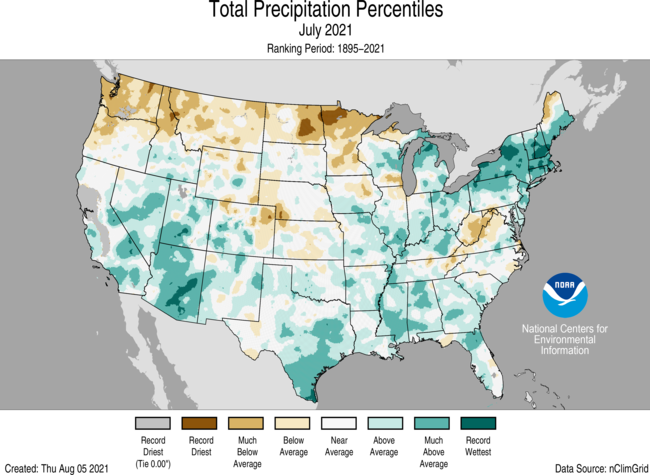 The average precipitation for last month was 3.36 inches (0.58 of an inch above average), making it the sixth-wettest July on record. Precipitation was above average across much of the Northeast, Southeast and South, as well as portions of the Midwest, Ohio Valley and Great Lakes. New York and Massachusetts had their wettest July on record.
Meanwhile, much of the Northwest and Northern Tier, as well as parts of the central Plains, Midwest and central Appalachians, had below-average precipitation. Minnesota and Washington saw their second- and fourth-driest July on record, respectively.
The Southwest monsoon season began in earnest during the second half of July, bringing some rainfall to the drought-stricken region. Portions of Colorado, Nevada, New Mexico, Utah and Arizona saw some improvement in the drought intensity, but still remain entrenched in drought.
Much of the West, particularly the Northwest, remained entrenched in exceptional drought conditions, which was reflected in very high wildfire activity throughout the month.
Year to date | January through July 2021
The average precipitation for last month was 3.36 inches (0.58 of an inch above average), making it the sixth-wettest July on record. Precipitation was above average across much of the Northeast, Southeast and South, as well as portions of the Midwest, Ohio Valley and Great Lakes. New York and Massachusetts had their wettest July on record.
Meanwhile, much of the Northwest and Northern Tier, as well as parts of the central Plains, Midwest and central Appalachians, had below-average precipitation. Minnesota and Washington saw their second- and fourth-driest July on record, respectively.
The Southwest monsoon season began in earnest during the second half of July, bringing some rainfall to the drought-stricken region. Portions of Colorado, Nevada, New Mexico, Utah and Arizona saw some improvement in the drought intensity, but still remain entrenched in drought.
Much of the West, particularly the Northwest, remained entrenched in exceptional drought conditions, which was reflected in very high wildfire activity throughout the month.
Year to date | January through July 2021
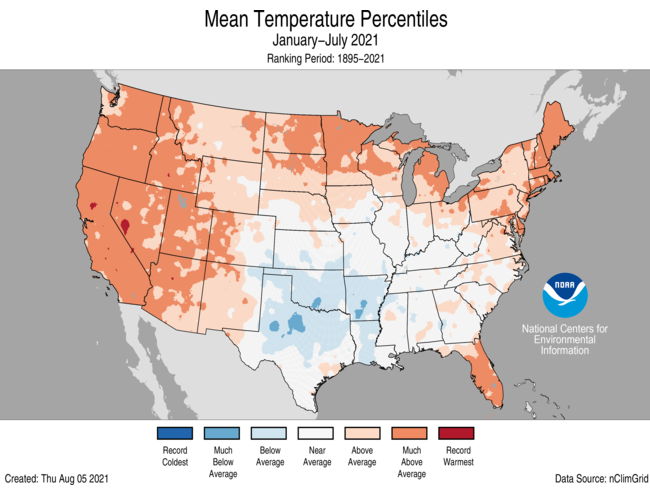 The year-to-date (YTD) average temperature for the contiguous U.S. was 53.0 degrees F (1.8 degrees above the average), making it the 14th-warmest YTD on record. California, Nevada and Oregon each saw their warmest YTD. 11 additional states across the West, northern Plains, Northeast and Southeast experiencing a top-10 warmest January-July.
Temperatures were above average across the West, northern and central Plains, Great Lakes, Northeast, mid-Atlantic and portions of the Southeast.
The first seven months of 2021 saw an average precipitation of 18.00 inches (0.09 of an inch below average), which ranked in the middle third of the record. Mississippi had its sixth-wettest YTD, while Minnesota and North Dakota saw their third driest.
Precipitation was above average from the southern and central Plains to the Midwest and into portions of the Southeast. Mississippi ranked sixth wettest for the first seven months of the year. Precipitation was below average from the West Coast to the western Great Lakes.
The year-to-date (YTD) average temperature for the contiguous U.S. was 53.0 degrees F (1.8 degrees above the average), making it the 14th-warmest YTD on record. California, Nevada and Oregon each saw their warmest YTD. 11 additional states across the West, northern Plains, Northeast and Southeast experiencing a top-10 warmest January-July.
Temperatures were above average across the West, northern and central Plains, Great Lakes, Northeast, mid-Atlantic and portions of the Southeast.
The first seven months of 2021 saw an average precipitation of 18.00 inches (0.09 of an inch below average), which ranked in the middle third of the record. Mississippi had its sixth-wettest YTD, while Minnesota and North Dakota saw their third driest.
Precipitation was above average from the southern and central Plains to the Midwest and into portions of the Southeast. Mississippi ranked sixth wettest for the first seven months of the year. Precipitation was below average from the West Coast to the western Great Lakes.
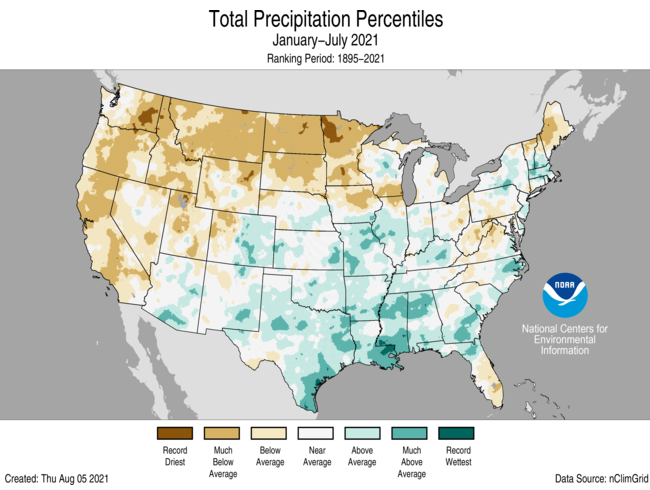 More notable climate events from the July report
More notable climate events from the July report
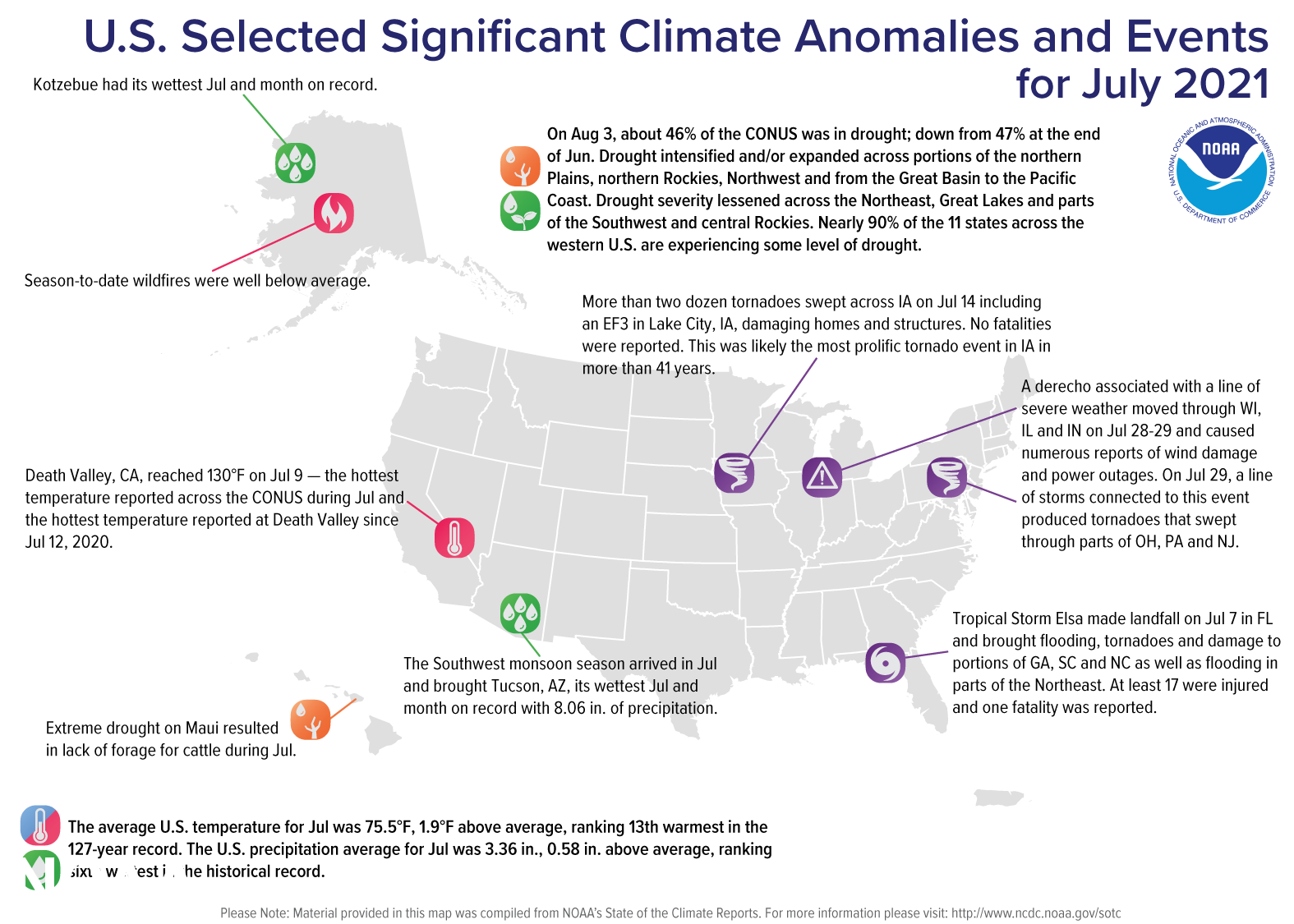 Edited for WeatherNation by Mace Michaels
Edited for WeatherNation by Mace Michaels
 The average temperature last month across the contiguous U.S. was 75.5 degrees F (1.9 degrees above average), placing July 2021 in the 13th-warmest spot in the 127-year record.
A ridge of high pressure across the western U.S and a trough across the eastern U.S. for most of July kept the temperatures well-above average across the West and more moderate across the central and eastern states. This pattern remained in place for the duration of the month. An eastward shift in the ridge mid-month allowed the southwestern monsoon to kick off.
California, Nevada, Oregon and Washington had their hottest Julys on record. Five other states — Idaho, Montana, North Dakota, Utah and Wyoming — saw their top-10 hottest Julys.
The average temperature last month across the contiguous U.S. was 75.5 degrees F (1.9 degrees above average), placing July 2021 in the 13th-warmest spot in the 127-year record.
A ridge of high pressure across the western U.S and a trough across the eastern U.S. for most of July kept the temperatures well-above average across the West and more moderate across the central and eastern states. This pattern remained in place for the duration of the month. An eastward shift in the ridge mid-month allowed the southwestern monsoon to kick off.
California, Nevada, Oregon and Washington had their hottest Julys on record. Five other states — Idaho, Montana, North Dakota, Utah and Wyoming — saw their top-10 hottest Julys.
 The average precipitation for last month was 3.36 inches (0.58 of an inch above average), making it the sixth-wettest July on record. Precipitation was above average across much of the Northeast, Southeast and South, as well as portions of the Midwest, Ohio Valley and Great Lakes. New York and Massachusetts had their wettest July on record.
Meanwhile, much of the Northwest and Northern Tier, as well as parts of the central Plains, Midwest and central Appalachians, had below-average precipitation. Minnesota and Washington saw their second- and fourth-driest July on record, respectively.
The Southwest monsoon season began in earnest during the second half of July, bringing some rainfall to the drought-stricken region. Portions of Colorado, Nevada, New Mexico, Utah and Arizona saw some improvement in the drought intensity, but still remain entrenched in drought.
Much of the West, particularly the Northwest, remained entrenched in exceptional drought conditions, which was reflected in very high wildfire activity throughout the month.
Year to date | January through July 2021
The average precipitation for last month was 3.36 inches (0.58 of an inch above average), making it the sixth-wettest July on record. Precipitation was above average across much of the Northeast, Southeast and South, as well as portions of the Midwest, Ohio Valley and Great Lakes. New York and Massachusetts had their wettest July on record.
Meanwhile, much of the Northwest and Northern Tier, as well as parts of the central Plains, Midwest and central Appalachians, had below-average precipitation. Minnesota and Washington saw their second- and fourth-driest July on record, respectively.
The Southwest monsoon season began in earnest during the second half of July, bringing some rainfall to the drought-stricken region. Portions of Colorado, Nevada, New Mexico, Utah and Arizona saw some improvement in the drought intensity, but still remain entrenched in drought.
Much of the West, particularly the Northwest, remained entrenched in exceptional drought conditions, which was reflected in very high wildfire activity throughout the month.
Year to date | January through July 2021
 The year-to-date (YTD) average temperature for the contiguous U.S. was 53.0 degrees F (1.8 degrees above the average), making it the 14th-warmest YTD on record. California, Nevada and Oregon each saw their warmest YTD. 11 additional states across the West, northern Plains, Northeast and Southeast experiencing a top-10 warmest January-July.
Temperatures were above average across the West, northern and central Plains, Great Lakes, Northeast, mid-Atlantic and portions of the Southeast.
The first seven months of 2021 saw an average precipitation of 18.00 inches (0.09 of an inch below average), which ranked in the middle third of the record. Mississippi had its sixth-wettest YTD, while Minnesota and North Dakota saw their third driest.
Precipitation was above average from the southern and central Plains to the Midwest and into portions of the Southeast. Mississippi ranked sixth wettest for the first seven months of the year. Precipitation was below average from the West Coast to the western Great Lakes.
The year-to-date (YTD) average temperature for the contiguous U.S. was 53.0 degrees F (1.8 degrees above the average), making it the 14th-warmest YTD on record. California, Nevada and Oregon each saw their warmest YTD. 11 additional states across the West, northern Plains, Northeast and Southeast experiencing a top-10 warmest January-July.
Temperatures were above average across the West, northern and central Plains, Great Lakes, Northeast, mid-Atlantic and portions of the Southeast.
The first seven months of 2021 saw an average precipitation of 18.00 inches (0.09 of an inch below average), which ranked in the middle third of the record. Mississippi had its sixth-wettest YTD, while Minnesota and North Dakota saw their third driest.
Precipitation was above average from the southern and central Plains to the Midwest and into portions of the Southeast. Mississippi ranked sixth wettest for the first seven months of the year. Precipitation was below average from the West Coast to the western Great Lakes.
 More notable climate events from the July report
More notable climate events from the July report
- Wildfires raged across the West: Wildfire activity exploded across the drought-stricken portions of the West, especially the Northwest. As of July 31, 37,650 fires had burned through nearly 3 million acres of the U.S. during the first seven months of 2021 — nearly 1 million more acres than were consumed by this time last year. As of July 31, the largest fire across the U.S., Oregon’s Bootleg Fire, had burned more than 413,000 acres and was 56% contained. The second-largest fire, the Dixie Fire in Northern California, consumed more than 240,000 acres and was 24% contained.
- Drought was down slightly: Approximately 46% of the contiguous U.S. was in drought by the beginning of August, down 1% from the end of June, according to the U.S. Drought Monitor report. Despite this, drought intensified and expanded across portions of the northern Plains, northern Rockies and Northwest, and from the Great Basin to the Pacific Coast. More than 90% of 11 western states — Arizona, California, Colorado, Idaho, Montana, Nevada, New Mexico, Oregon, Utah, Washington and Wyoming — were experiencing some level of drought by the end of July.
- Elsa struck the U.S.: Hurricane Elsa formed in early July and made landfall as a tropical storm in Florida on July 7. The storm brought flooding, tornadoes and damage to portions of Georgia and the Carolinas, and flooding to parts of the Northeast. Elsa was the earliest fifth-named storm on record for the Atlantic basin. At least 17 were injured and one fatality was reported.
 Edited for WeatherNation by Mace Michaels
Edited for WeatherNation by Mace MichaelsAll Weather News
More